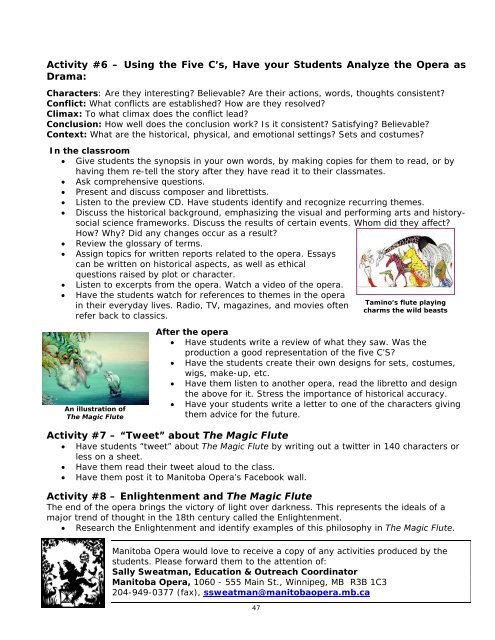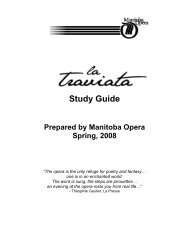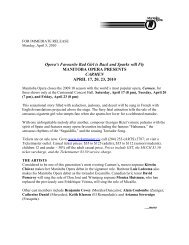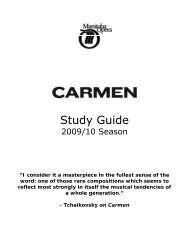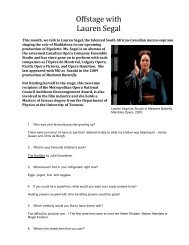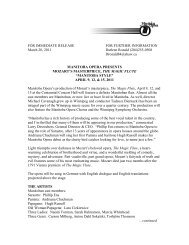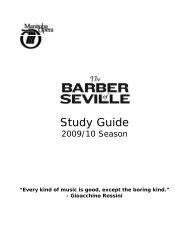The Magic Flute Study Guide - Manitoba Opera
The Magic Flute Study Guide - Manitoba Opera
The Magic Flute Study Guide - Manitoba Opera
You also want an ePaper? Increase the reach of your titles
YUMPU automatically turns print PDFs into web optimized ePapers that Google loves.
Activity #6 – Using the Five C’s, Have your Students Analyze the <strong>Opera</strong> as<br />
Drama:<br />
Characters: Are they interesting? Believable? Are their actions, words, thoughts consistent?<br />
Conflict: What conflicts are established? How are they resolved?<br />
Climax: To what climax does the conflict lead?<br />
Conclusion: How well does the conclusion work? Is it consistent? Satisfying? Believable?<br />
Context: What are the historical, physical, and emotional settings? Sets and costumes?<br />
In the classroom<br />
� Give students the synopsis in your own words, by making copies for them to read, or by<br />
having them re-tell the story after they have read it to their classmates.<br />
� Ask comprehensive questions.<br />
� Present and discuss composer and librettists.<br />
� Listen to the preview CD. Have students identify and recognize recurring themes.<br />
� Discuss the historical background, emphasizing the visual and performing arts and historysocial<br />
science frameworks. Discuss the results of certain events. Whom did they affect?<br />
How? Why? Did any changes occur as a result?<br />
� Review the glossary of terms.<br />
� Assign topics for written reports related to the opera. Essays<br />
can be written on historical aspects, as well as ethical<br />
questions raised by plot or character.<br />
� Listen to excerpts from the opera. Watch a video of the opera.<br />
� Have the students watch for references to themes in the opera<br />
in their everyday lives. Radio, TV, magazines, and movies often<br />
refer back to classics.<br />
An illustration of<br />
<strong>The</strong> <strong>Magic</strong> <strong>Flute</strong><br />
After the opera<br />
� Have students write a review of what they saw. Was the<br />
production a good representation of the five C’S?<br />
� Have the students create their own designs for sets, costumes,<br />
wigs, make-up, etc.<br />
� Have them listen to another opera, read the libretto and design<br />
the above for it. Stress the importance of historical accuracy.<br />
� Have your students write a letter to one of the characters giving<br />
them advice for the future.<br />
Activity #7 – “Tweet” about <strong>The</strong> <strong>Magic</strong> <strong>Flute</strong><br />
� Have students “tweet” about <strong>The</strong> <strong>Magic</strong> <strong>Flute</strong> by writing out a twitter in 140 characters or<br />
less on a sheet.<br />
� Have them read their tweet aloud to the class.<br />
� Have them post it to <strong>Manitoba</strong> <strong>Opera</strong>’s Facebook wall.<br />
Activity #8 – Enlightenment and <strong>The</strong> <strong>Magic</strong> <strong>Flute</strong><br />
<strong>The</strong> end of the opera brings the victory of light over darkness. This represents the ideals of a<br />
major trend of thought in the 18th century called the Enlightenment.<br />
� Research the Enlightenment and identify examples of this philosophy in <strong>The</strong> <strong>Magic</strong> <strong>Flute</strong>.<br />
<strong>Manitoba</strong> <strong>Opera</strong> would love to receive a copy of any activities produced by the<br />
students. Please forward them to the attention of:<br />
Sally Sweatman, Education & Outreach Coordinator<br />
<strong>Manitoba</strong> <strong>Opera</strong>, 1060 - 555 Main St., Winnipeg, MB R3B 1C3<br />
204-949-0377 (fax), ssweatman@manitobaopera.mb.ca<br />
47<br />
Tamino’s flute playing<br />
charms the wild beasts


